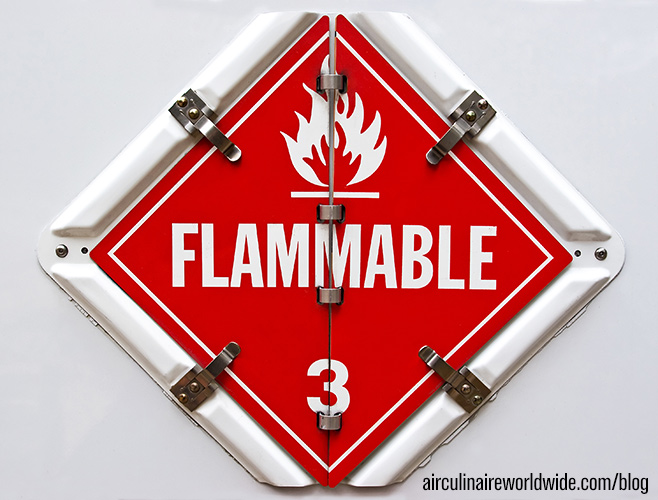As flight attendants, we must always be aware of not only what our passengers bring onboard, but also of what we bring onboard to maintain our aircraft. Hazardous Materials (HAZMAT) are all around us. We must be alert and able to recognize potentially hazardous materials that could affect our flight.
HAZMAT refers to an article or substance that has potentially hazardous characteristics. When transported, these items are capable of posing a risk to health, safety and property unless proper precautions are taken. There are two categories of HAZMAT:
- Forbidden – These items are too dangerous to be transported.
- Accepted – Regulations allow transport of these items if regulatory requirements are followed.
Here is a review for corporate flight attendants of the nine classes of hazardous materials:
Class 1 – Explosives
Examples: Fireworks, loose ammunition, dynamite, flares, gunpowder, loaded firearms.
Commonly found as: Security, passengers who carry weapons or are going on a hunting trip, fireworks (especially during holidays or going on vacation). Ammunition can be transported in checked luggage and securely packaged in material designed for that purpose.
Class 2 – Gasses
Examples: Tear gas, SCUBA tanks, propane, oxygen tanks, Mace, CO₂ cartridges.
Accepted items: Toiletry and medical articles, life rafts, life vests, portable oxygen bottles, hydrocarbon hair curlers.
Class 3 – Flammable Liquids
Examples: Gasoline, flammable paints, cigarette lighters, cleaning solvents, alcohol, acetone, colognes
Accepted items: Alcohol beverages, acetone, perfumes, lighters that contain liquefied gas, jet fuel, skydrol.
Class 4 – Flammable Solids
Examples: Sulfur, potassium metals, charcoal
Accepted items: Flare required onboard an aircraft according to airworthiness requirements and magnesium wheel wells.
Class 5 – Oxidizers
Examples: Bleach, ammonium nitrate, fertilizer
Accepted items: Hydrogen peroxide, oxygen generators used in PSU.
Class 6 – Poisons
Examples: Tear gas, nicotine, botulism, tetanus, and medical and clinical waste
Accepted items: Diagnostic specimens and medical and clinical waste
Class 7 – Radioactive Materials
Examples: Smoke detectors, radioactive pharmaceuticals and nuclear materials
Accepted items: Pacemakers, certain smoke detectors
Class 8 – Corrosive Materials
Examples: Battery acids, alkali, photographic material, drain cleaners, mercury thermometers
Accepted items: Wet cell batteries and mercury thermometers.
Class 9 – Miscellaneous Materials
Accepted items are dry ice, transport incubator and magnetized materials
In addition to being familiar with and regularly reviewing HAZMAT classifications, be on the lookout for boxes with special handling instructions. These boxes may include materials that may leak. Always check for documentation or declaration of dangerous goods. Remember: “When in doubt, check it out!” If an item is labeled with a diamond-shaped symbol, it is most likely HAZMAT.
HAZMAT contact information number for the Office of Aviation Security, responsible for the hazardous materials function of the Federal Aviation Administration: +1-202-267-3099.
Questions?
If you have any questions about this article or about aviation safety, contact me at johndetloff@airculinaire.com.






